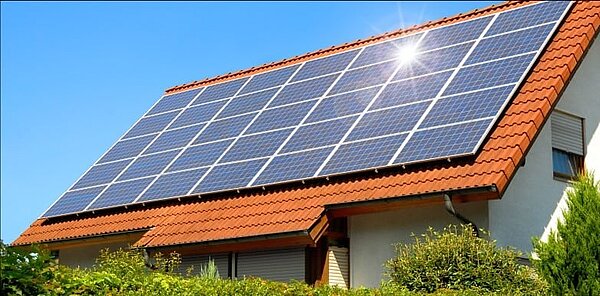Digitization and Blockchain are making their way into the PV Industry
by Bernhard Jodeleit | 07.11.2019

Hardly any other industry recognizes and exploits the advantages of digitization as intensively as the PV sector. In the meter cabinet, where just a few years ago rows and rows of magnetically driven meter discs were still turning in old-fashioned black electricity meter housings, the blockchain will soon be making its entrance, and with it a decentrally organized energy market.
What does blockchain mean in relation to PV energy?
Blockchain literally means "blockchain." Behind it is a decentralized network of computers that collectively store and manage an encrypted string of transaction data (the "blocks" in the form of a "chain"). Its advantage: making transactions - and thus trading - possible without a central coordinating body. The functions of a bank or an exchange are performed in a decentralized manner by many participants with equal rights. This makes the market more agile and allows the players to work at eye level.
Digitization = Automated, decentralized power trading for PV systems.
It is true that the general public often equates "blockchain" with "Bitcoin," the digital currency much discussed in the media. True, Bitcoin is based on the blockchain. However, a blockchain (there are many blockchains, not just Bitcoins!) can do much more. Among other things, in the future it will also make it possible to share photovoltaic modules among neighbors in a city neighborhood. Alternatively, it opens the way to automatic electricity trading between small, regionally affiliated, electricity providers - such as a group of property owners.
Smart contracts: Electricity for credit in the blockchain
How it works: In simple terms, a blockchain allows transactions to be recorded in a tamper-proof way in a decentralized infrastructure, comparable to a checking account without a bank in the background. Participants can transfer amounts to each other, but also enter into contracts with each other, so-called smart contracts. This makes the blockchain appealing for the creation of digital currencies. With the help of a blockchain, all kinds of things can be traded. Money, shares in all conceivable material assets - and that includes electricity: you supply me with a kilowatt hour of electricity in a phase with little sunshine - and receive X cents in return. Or amount X in a cryptocurrency.
New energy currencies on the horizon
There are no limits to the imagination. Thus, there are a multitude of blockchain applications worldwide and also "currencies" - Bitcoin, Ethereum & Co. are just the tip of the iceberg. Basically, any organization, even any person, can launch their own currency based on blockchain technology. This is neither incredibly complex nor particularly expensive. The challenge is rather having a good idea and also the right network behind every new blockchain application or currency. Only then can a market emerge.
The advantages of blockchain for a market suitable for it are manifold. Costs for intermediaries and exchanges are eliminated. Transactions that were previously only worthwhile for large market players become interesting and lucrative for smaller market participants thanks to Blockchain.
Direct Marketing: An Option for Digital Power Trading
Direct marketing of PV electricity has already become increasingly attractive in recent years as feed-in tariffs have fallen, and can certainly be seen as a precursor to blockchain business models. The first steps towards digital electricity trading have already been taken. Blockchain will accelerate this development. Today, Solar-Log™ already supports and simplifies the direct marketing of decentrally generated electricity from medium-sized and larger PV plants. In the future, such direct marketing will also become lucrative for small and micro PV power producers, thanks to blockchain. The basis for this is a system-open, flexible, and future-proof data platform, which is installed with the PV system or can simply be retrofitted, such as with the Solar-Log™ energy management system.
In the future, this will be favored by the fact that blockchain transactions are tamper-proof, flexible, digital, and ideally also fast. They can be perfectly evaluated and linked thanks to systems that are open and flexible. Washing machines that buy their own electricity? PV modules that participate in auctions in a decentralized electricity market and achieve the best price in the interests of their owner? Sounds like science fiction, but thanks to blockchain, it's within reach. Solar-Log™ is watching the progress of blockchain technology very closely and will make its technological advantages available to current and future customers.
Systems will automatically trade electricity with each other
So the opportunities that Blockchain presents are quite fantastic in the energy sector. Consequently, the goal in the PV sector is to establish systems based on blockchain technology that will automatically trade electricity with each other and distribute regeneratively generated electricity as ideally as possible. There is a lot to consider here, not least in the area of data protection. After all, information should not circulate uncontrolled, such as: "the residents of house Lilienweg 23 are currently not using any electricity, so they are not at home."
That sounds a bit like the future and has not yet reached everyday life, except in pilot projects.
Digitalization in the Electricity Market has already begun with Tenant Electricity
What still works without blockchain and not independent of the electricity provider, but already decentralized in its approach, is tenant electricity in addition to direct marketing. Tenant electricity enables more people to participate directly in the energy transition. They can, thanks to decentralized production, obtain cheaper electricity instead of more expensive. Finally, self-consumption of electricity generated with photovoltaics is always the best solution. Better to use it yourself than to feed it into the grid! Initiatives by politicians, associations, and companies have therefore been paving the way for tenant electricity for some years now, sometimes and especially in Switzerland also called "Quartierstrom".
Tenant Electricity is Collective Self-Consumption
Tenant electricity is a smart variant of self-consumption of solar power: collective self-consumption. Let's assume a builder completes an apartment building - sensibly with a photovoltaic system on the roof. A tenant electricity solution makes it possible for all residents in the building to benefit from lower electricity prices.
 More decentralized and consumer-friendly: Owners have been benefiting from cost advantages through rooftop PV for some time, while tenants have been able to enjoy some of the benefits in grid fees since 2017.
More decentralized and consumer-friendly: Owners have been benefiting from cost advantages through rooftop PV for some time, while tenants have been able to enjoy some of the benefits in grid fees since 2017.
Electricity from own production also for tenants
This is tenant electricity, and in concrete terms it means that the residents draw as much electricity as possible from the in-house system; surpluses are fed into the grid, and additional requirements are supplied by the grid operator. Previously, this was also possible, but not for tenants. With the introduction of tenant electricity concepts in 2017, tenants were put on a more equal footing with owners. The regional energy supplier takes care of the electricity customers and their contracts, the reading of the meters and the billing. Many of the electricity giants have now launched corresponding offers on the market. The website of the "Federal Ministry for Economic Affairs and Energy" also has a section with frequently asked questions about tenant electricity for interested building owners.
Five Advantages of Blockchain for the PV Industry
In the industry, people are optimistic and expect a further decentralization of the electricity market. Photovoltaics and blockchain are equally distributed technologies. That harmonizes. Blockchain could soon be used in many ways in the PV industry, it can support in:
- Democratizing the energy market.
- Balancing supply and demand in the power grid.
- Building a decentralized infrastructure (microgrids).
- Creating new markets and incentives for renewable energy through peer-to-peer energy trading.
- Creating new markets by introducing new tokens and "currencies" in the field of renewable energies; one example is "Solarcoin".
- Optimizing the electricity market to ever more demand-driven production and higher stability through smart contracts.
What's next for photovoltaic digitization and PV blockchain?
Time and again, blockchain applications are also criticized for being just a lot of short-term hype, and for having fundamental drawbacks, such as current or future security flaws (keyword: quantum computers are emerging that are so powerful that they can crack the security encryption of blockchains).
What is not ideal is the high energy consumption of some blockchains. However, this affects Bitcoin rather than modern specialty blockchains. In general, great strides are now being made in blockchain energy consumption. Blockchain transactions now use much less energy in modern processes than they did just a few years ago.
Hurdles continue to include high grid fees, which can sometimes stand in the way of smart grid solutions. Here, companies, politicians, and associations are campaigning at the European level to create better framework conditions for smart grids and digitization of the energy supply.
Conclusion of current developments in digitization: the grid is becoming more decentralized, modern and democratic
So it remains exciting - the power grid is becoming more decentralized, more digital, and somewhere also more democratic thanks to digitalization. We at Solar-Log™ definitely support this transfer around the triumph of renewable energy sources and decentralization in the future.
Back to the overview


